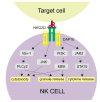NKG2D Natural Killer Cell Receptor-A Short Description and Potential Clinical Applications
- PMID: 34200375
- PMCID: PMC8229527
- DOI: 10.3390/cells10061420
NKG2D Natural Killer Cell Receptor-A Short Description and Potential Clinical Applications
Abstract
Natural Killer (NK) cells are natural cytotoxic, effector cells of the innate immune system. They can recognize transformed or infected cells. NK cells are armed with a set of activating and inhibitory receptors which are able to bind to their ligands on target cells. The right balance between expression and activation of those receptors is fundamental for the proper functionality of NK cells. One of the best known activating receptors is NKG2D, a member of the CD94/NKG2 family. Due to a specific NKG2D binding with its eight different ligands, which are overexpressed in transformed, infected and stressed cells, NK cells are able to recognize and attack their targets. The NKG2D receptor has an enormous significance in various, autoimmune diseases, viral and bacterial infections as well as for transplantation outcomes and complications. This review focuses on the NKG2D receptor, the mechanism of its action, clinical relevance of its gene polymorphisms and a potential application in various clinical settings.
Keywords: NK cells; NKG2D ligands; NKG2D receptor.
Conflict of interest statement
The authors declare no conflict of interest.
Figures


Similar articles
-
Role of Polymorphisms of NKG2D Receptor and Its Ligands in Acute Myeloid Leukemia and Human Stem Cell Transplantation.Front Immunol. 2021 Mar 30;12:651751. doi: 10.3389/fimmu.2021.651751. eCollection 2021. Front Immunol. 2021. PMID: 33868289 Free PMC article. Review.
-
NKG2D and Its Ligands: "One for All, All for One".Front Immunol. 2018 Mar 12;9:476. doi: 10.3389/fimmu.2018.00476. eCollection 2018. Front Immunol. 2018. PMID: 29662484 Free PMC article. Review.
-
Viral inhibitors of NKG2D ligands for tumor surveillance.Expert Opin Ther Targets. 2016 Nov;20(11):1375-1387. doi: 10.1080/14728222.2016.1202928. Epub 2016 Jun 29. Expert Opin Ther Targets. 2016. PMID: 27322108 Review.
-
Advances in NKG2D ligand recognition and responses by NK cells.Immunol Cell Biol. 2014 Mar;92(3):230-6. doi: 10.1038/icb.2013.111. Epub 2014 Jan 21. Immunol Cell Biol. 2014. PMID: 24445601 Review.
-
Natural killer group 2D receptor and its ligands in cancer immune escape.Mol Cancer. 2019 Feb 27;18(1):29. doi: 10.1186/s12943-019-0956-8. Mol Cancer. 2019. PMID: 30813924 Free PMC article. Review.
Cited by
-
Harnessing the Power of NK Cell Receptor Engineering as a New Prospect in Cancer Immunotherapy.Pharmaceutics. 2024 Aug 29;16(9):1143. doi: 10.3390/pharmaceutics16091143. Pharmaceutics. 2024. PMID: 39339180 Free PMC article. Review.
-
WTAP enhances the instability of SYTL1 mRNA caused by YTHDF2 in bladder cancer.Histol Histopathol. 2024 May;39(5):633-646. doi: 10.14670/HH-18-671. Epub 2023 Oct 23. Histol Histopathol. 2024. PMID: 37933909
-
Activating NKG2C Receptor: Functional Characteristics and Current Strategies in Clinical Applications.Arch Immunol Ther Exp (Warsz). 2023 Mar 10;71(1):9. doi: 10.1007/s00005-023-00674-z. Arch Immunol Ther Exp (Warsz). 2023. PMID: 36899273 Free PMC article. Review.
-
Natural Killer Cells in Graves' Disease: Increased Frequency but Impaired Degranulation Ability Compared to Healthy Controls.Int J Mol Sci. 2025 Jan 24;26(3):977. doi: 10.3390/ijms26030977. Int J Mol Sci. 2025. PMID: 39940745 Free PMC article.
-
TGF-β Signaling in Cancer: Mechanisms of Progression and Therapeutic Targets.Int J Mol Sci. 2025 Jul 29;26(15):7326. doi: 10.3390/ijms26157326. Int J Mol Sci. 2025. PMID: 40806457 Free PMC article. Review.
References
-
- Stewart C.A., Vivier E., Colonna M. Strategies of Natural Killer Cell Recognition and Signaling. In: Vivier E., Colonna M., editors. Immunobiology of Natural Killer Cell Receptors. Volume 298. Springer; Berlin/Heidelberg, Germany: 2006. pp. 1–21. - PubMed
Publication types
MeSH terms
Substances
LinkOut - more resources
Full Text Sources
Medical

